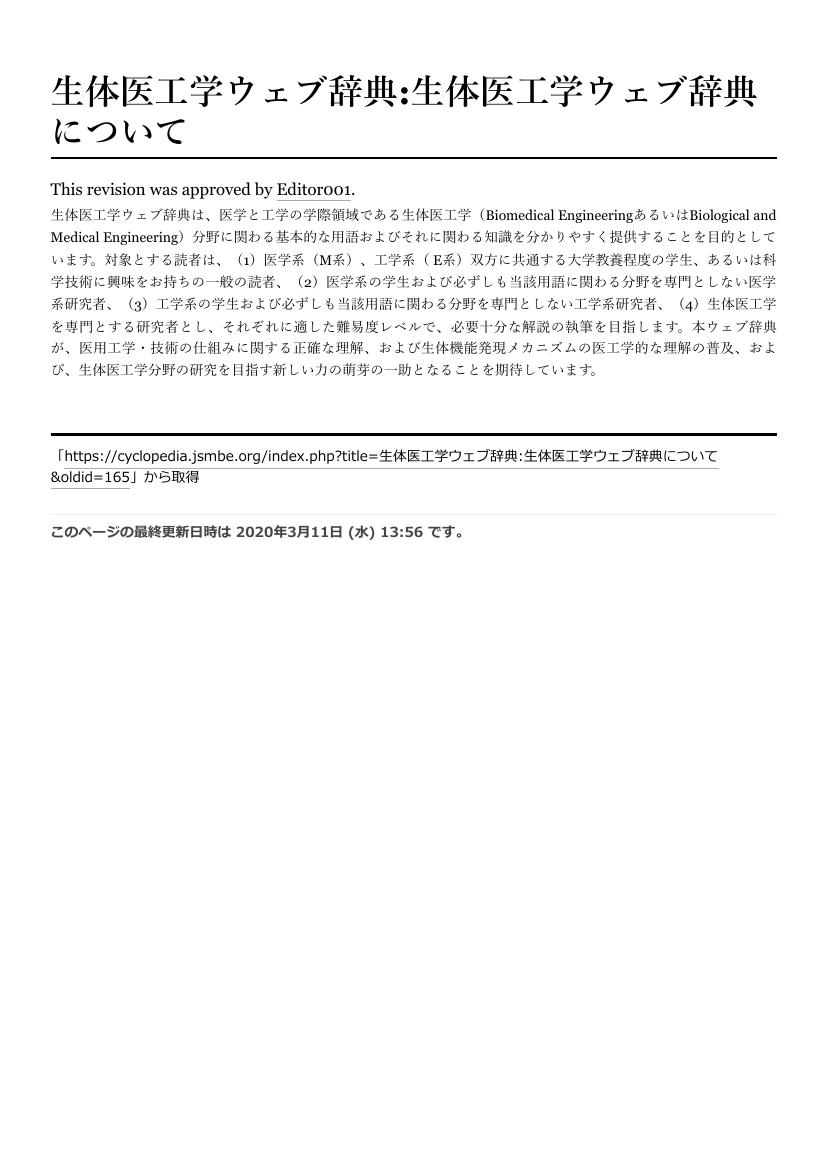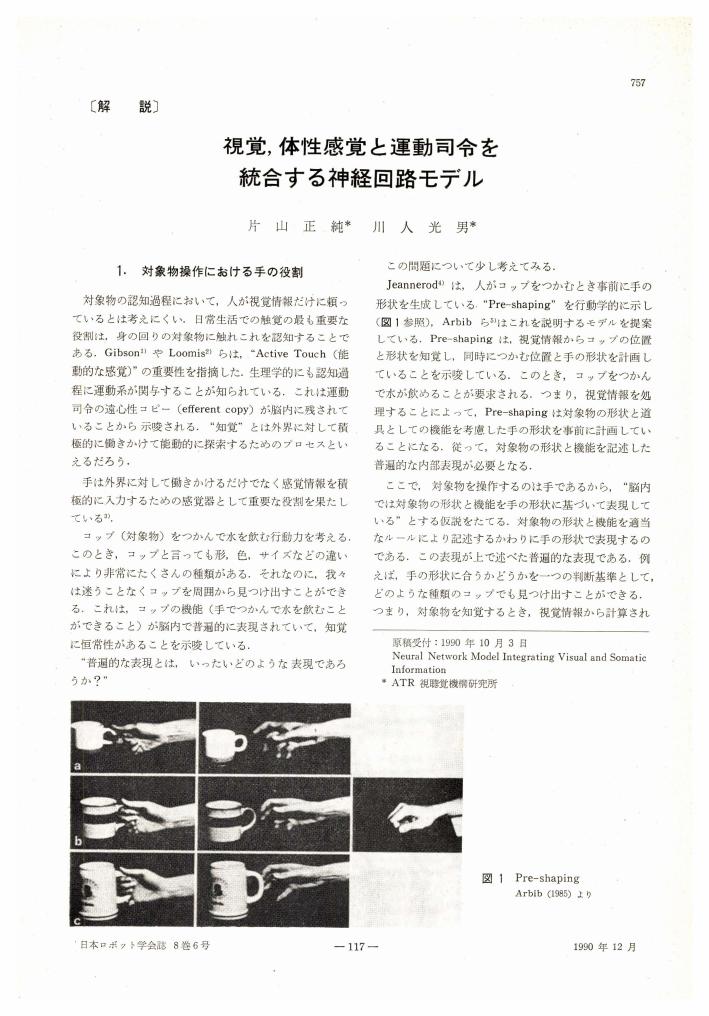2 0 0 0 OA 飢餓による消化管の変化と食事の再投与による回復について
- 著者
- 片山 (須川) 洋子
- 出版者
- The Japan Society of Home Economics
- 雑誌
- 日本家政学会誌 (ISSN:09135227)
- 巻号頁・発行日
- vol.38, no.9, pp.787-792, 1987-09-20 (Released:2010-03-10)
- 参考文献数
- 11
This study is designed to clarify the changes of composition and enzyme activities of the small intestinal mucosa in fasted rats.Starvation for 3 days caused marked decreases in body weight, DNA and protein of small intestinal mucosa, and the activities of digestive enzymes.After starvation for 3 days, rats were refed with the laboratory chow for 1, 3 and 7 days.1) The body weight of rats recovered in 3 days.2) The recovery of the small intestinal mucosa was very rapid, especially its dry weight and DNA.3) Both sucrase and alkaline phosphatase activities increased markedly, then returned to the control level in 7 days.
2 0 0 0 OA 生体医工学ウェブ辞典(第一分冊)
- 著者
- 相川 慎也 芦原 貴司 天野 晃 有末 伊織 安藤 譲二 伊井 仁志 出江 紳一 伊東 保志 稲田 慎 井上 雅仁 今井 健 岩下 篤司 上村 和紀 内野 詠一郎 宇野 友貴 江村 拓人 大内田 研宙 大城 理 太田 淳 太田 岳 大谷 智仁 大家 渓 岡 崇史 岡崎 哲三 岡本 和也 岡山 慶太 小倉 正恒 小山 大介 海住 太郎 片山 統裕 勝田 稔三 加藤 雄樹 加納 慎一郎 鎌倉 令 亀田 成司 河添 悦昌 河野 喬仁 紀ノ定 保臣 木村 映善 木村 真之 粂 直人 藏富 壮留 黒田 知宏 小島 諒介 小西 有人 此内 緑 小林 哲生 坂田 泰史 朔 啓太 篠原 一彦 白記 達也 代田 悠一郎 杉山 治 鈴木 隆文 鈴木 英夫 外海 洋平 高橋 宏和 田代 洋行 田村 寛 寺澤 靖雄 飛松 省三 戸伏 倫之 中沢 一雄 中村 大輔 西川 拓也 西本 伸志 野村 泰伸 羽山 陽介 原口 亮 日比野 浩 平木 秀輔 平野 諒司 深山 理 稲岡 秀検 堀江 亮太 松村 泰志 松本 繁巳 溝手 勇 向井 正和 牟田口 淳 門司 恵介 百瀬 桂子 八木 哲也 柳原 一照 山口 陽平 山田 直生 山本 希美子 湯本 真人 横田 慎一郎 吉原 博幸 江藤 正俊 大城 理 岡山 慶太 川田 徹 紀ノ岡 正博 黒田 知宏 坂田 泰史 杉町 勝 中沢 一雄 中島 一樹 成瀬 恵治 橋爪 誠 原口 亮 平田 雅之 福岡 豊 不二門 尚 村田 正治 守本 祐司 横澤 宏一 吉田 正樹 和田 成生
- 出版者
- 公益社団法人 日本生体医工学会
- 雑誌
- 生体医工学 (ISSN:1347443X)
- 巻号頁・発行日
- vol.Dictionary.1, pp.1-603, 2022 (Released:2022-03-31)
2 0 0 0 IR 「うはなり」「こなみ」の諸相(1):平安時代を中心に
- 著者
- 片山 剛 千里金蘭大学 教養教育センター
- 巻号頁・発行日
- no.14, pp.127-138,
夫が新たに別の妻を持つ場合、元の妻を「こなみ」、後の妻を「うはなり」と言った。そして「こなみ」はしばしば「うはなり」を憎むあまり暴力を振るう(あるいは人を使って振るわせる)こともあった。これが「うはなり打ち」である。しかし「こなみ」と「うはなり」が仲睦まじいこともありえたし、「うはなり打ち」がおこなわれる場合でも時代によってその性格は異なっていたようで、また同じ時代でもすべて同じようにおこなわれたわけでもなかった。本稿では、平安時代の文学を中心にしつつ、前後の時代にも目配りして「うはなり」「こなみ」の様相をたどる。
- 著者
- 幸村 明典 片山 謙吾 南原 英生
- 出版者
- 岡山理科大学
- 雑誌
- 岡山理科大学紀要. A, 自然科学 (ISSN:02857685)
- 巻号頁・発行日
- vol.46, pp.39-48, 2010
- 著者
- 片山 きよみ 舛井 雅子
- 出版者
- 熊本大学
- 雑誌
- 熊本大学留学生センター紀要 (ISSN:1881834X)
- 巻号頁・発行日
- vol.9, pp.25-53, 2006-03-27
初・中級の日本語教科書で取り上げられている副詞の中から、「とても」「すごく」「ひどく」「非常に」「大変」「本当に」の異同について検証する。用例の比較検証によって、それぞれの副詞には口語的か文章語的か、改まった表現かくだけた表現か、主観的か客観的かという対立に加え、種々の構文(否定文、比較構文、命令文、直接的な感謝やお詫びの表現など)における使用制限に違いがあることを明らかにする。
- 著者
- 片山 徹 手嶋 晃 池田 良穂
- 出版者
- 社団法人 日本船舶海洋工学会
- 雑誌
- 関西造船協会論文集 (ISSN:13467727)
- 巻号頁・発行日
- vol.2001, no.236, pp.181-190, 2001
- 参考文献数
- 9
- 被引用文献数
- 1
An experimental investigation on the transverse porpoising instability of a planning craft in drifting motion at high advance speeds in calm water is carried out. Some types of transverse porpoising are observed in measuring motions in oblique towing tests under heave, pitch and roll free condition. In order to clarify the influence of hydrodynamic forces on the transverse porpoising, captive model tests in oblique towing condition are carried out. The experiments are carried out by systematically changing trim angle, drift angle, towing speed and draft. From the measured hydrodynamic forces, the restoring forces and moments of heave, roll and pitch are calculated. The results show that the coupling restoring coefficients between heave and pitch have the different sign each other(∂F_z/∂θ>0, ∂M_y/∂z<0)and the coupling restoring coefficients between heave and roll also have the different sign each other (∂F_z/∂ψ>0, ∂M_x/∂z<0)at large drift angle. The results suggest that the transverse porpoising considering in the present paper may be a self-excited phenomena in a coupling motion among roll, pitch and heave.
2 0 0 0 OA 茨城県北浦におけるチャネルキャットフィッシュの年齢と成長
- 著者
- 遠藤 友樹 加納 光樹 所 史隆 荒井 将人 片山 知史
- 出版者
- 公益社団法人 日本水産学会
- 雑誌
- 日本水産学会誌 (ISSN:00215392)
- 巻号頁・発行日
- pp.16-00057, (Released:2016-11-25)
- 参考文献数
- 33
- 被引用文献数
- 3 3
2014年4月から2015年3月に茨城県北浦において採集した侵略的外来種のチャネルキャットフィッシュ計937個体の耳石を解析し,本種の年齢と成長について調べた。耳石縁辺部の不透明帯は1年に1本,5-6月に形成され,この時期は産卵盛期と一致していた。von Bertalanffyの成長式は雌雄間で有意に異なり,雄が雌よりも成長速度が速い傾向が認められた。最高年齢は雄で14歳,雌で13歳と推定された。さらに,本種の個体群構造の推定や防除計画の立案に有用な年齢-体長換算表を作成した。
2 0 0 0 ハナキリンアントシアニンによるアニオン化絹の染色
- 著者
- 山本 好和 熊沢 敦子 坂田 佳子 木下 靖浩 片山 明
- 出版者
- 日本蠶絲學會
- 雑誌
- 日本蠶絲學雜誌 (ISSN:00372455)
- 巻号頁・発行日
- vol.71, no.1, pp.27-31, 2002-04-30
- 参考文献数
- 8
- 被引用文献数
- 2
マダガスカル島原産の観賞用植物であるハナキリンを組織培養することによって生産された単一のアントシアニン (シアニジン-3-アラビノシド) で, アニオン化された絹を染色した。被染素材としてアニオン化された絹を用いることで, 鮮やかな赤色を呈するフラビリウムカチオンが濃着染色されること, およびカチオン色素が繊維中で安定化することを明らかにした。また, フラビリウムカチオンが染色したアニオン化絹に対する種々の金属塩による後媒染および耐光性への影響を調べた。
2 0 0 0 OA 血栓化を伴った未破裂巨大脳動脈瘤 ―治療困難例の検討―
- 著者
- 加納 恒男 平山 晃康 片山 容一
- 出版者
- 一般社団法人 日本脳卒中の外科学会
- 雑誌
- 脳卒中の外科 (ISSN:09145508)
- 巻号頁・発行日
- vol.31, no.5, pp.344-348, 2003 (Released:2008-03-18)
- 参考文献数
- 18
- 被引用文献数
- 8 9
Thrombosed giant aneurysm (TGA) possesses a high growth potential. In patients with TGAs, clinical symptoms evolve most commonly from its mass effect. Surgical interventions are therefore required to prevent TGA growth. We analyze the clinical characteristics and histopathological findings of TGAs, and discuss possible mechanisms underlying their growth. We have treated 30 cases of TGA during the last 10 years. Of these, 10 underwent direct surgery and 20 were treated by endovascular surgery. Endovascular obliteration of TGAs frequently fails to terminate their growth when contrast-enhancement of the aneurysmal wall is demonstrated on CT or MRI. Incomplete endovascular obliteration of TGAs does not appear to reduce their growth potential. Complete thrombosis of TGAs, induced either spontaneously or by surgical modification of the blood flow, does not necessarily indicate termination of their growth. The growth of TGAs can be terminated when both the aneurysmal lumen and vascular channels of the aneurysmal wall are physically isolated from the blood flow through direct surgery: neck clipping or trapping. Together with the histopathological findings of TGAs, the above-mentioned characteristics suggest that 2 mechanisms may underlie their growth: intraluminal thrombus accumulation, and proliferation of vascular channels of the aneurysmal wall. Radical surgery to isolate TGAs from the blood flow, before they become too large to be operated on safely, may be advisable.
2 0 0 0 OA 「病気になるということ」訳出について
- 著者
- 片山 亜紀
- 出版者
- 日本ヴァージニア・ウルフ協会
- 雑誌
- ヴァージニア・ウルフ研究 (ISSN:02898314)
- 巻号頁・発行日
- vol.37, pp.129-132, 2020 (Released:2021-01-13)
2 0 0 0 スポーツ歯科医人伝 第3報 : 黒木正克先生
- 著者
- 石川 慎士 片山 幸太郎 糸賀 裕
- 出版者
- 日本歯科医史学会
- 雑誌
- 日本歯科医史学会会誌 (ISSN:02872919)
- 巻号頁・発行日
- vol.26, no.1, pp.29-54, 2005-03-30
- 参考文献数
- 253
- 被引用文献数
- 3
我々は日本のスポーツ界に偉大な足跡を残した歯科医師に関する一連の研究の実施を企画した.すなわち,スポーツとの関わり合いが深く,歯科医学に対して,またスポーツに対して,多大なる貢献をなされた諸先覚の業績を記録していくことにより,スポーツ歯学という新しい分野の歴史的発展への道標のひとつにしたいと考えた.今回は昭和32年から昭和38年まで6年に亘りプロボクサーとしてフェザー級及びバンタム級で活躍した歯科医師黒木正克先生の業績について報告する.黒木先生は昭和32年,1958年度西日本フェザー級新人王戦でプロデビューを果たし,見事西日本フェザー級新人王に輝いた.その後も本格的なボクサータイプのKOボクサーとして関西のボクシング界を中心としてその名を全国に馳せ,フェザー級6位およびバンタム級5位にランクされた.最終戦績は49戦25勝(12KO・TKO)18敗3分け3エキジビジョンの輝かしいものだった.
2 0 0 0 聖人崇敬をめぐって--西欧カトリック世界と東方ビザンツ世界
- 著者
- 片山 佳子
- 出版者
- 園田学園女子大学
- 雑誌
- 園田学園女子大学論文集 (ISSN:02862816)
- 巻号頁・発行日
- no.19, pp.p39-51, 1985-03
2 0 0 0 21世紀の不動産再開発をめぐる諸問題
- 著者
- 浅見 泰司 片山 さつき 鈴木 真生 田中 啓一 原科 幸彦 三橋 博巳
- 出版者
- Japan Association for Real Estate Sciences
- 雑誌
- 日本不動産学会誌 (ISSN:21859531)
- 巻号頁・発行日
- vol.17, no.3, pp.18-53, 2004
2 0 0 0 OA マイクロウェーブ照射による新しい脳損傷モデルの病態解析
マイクロ波をラットの脳に照射した脳損傷モデルを作成し、病理組織学的に検討した。3.0kWのマイクロ波を0.1秒間照射し、照射後1,3,7,14,28日に脳を摘出し、大脳皮質運動野、海馬、側脳室脈絡膜について神経細胞数の変化とTUNEL陽性細胞の割合を計数した。側脳室脈絡膜と脳室周囲が特異的に傷害された動物モデルとして爆傷による脳損傷が報告されており、マイクロ波照射による外傷性能損傷と病理組織学的な共通点が見出された。本脳損傷モデルは、マイクロ波発生装置を用いて出力を調節し、量的に再現性の高い脳損傷モデルを作製可能で、blast injuryに類似した新しい脳損傷モデルの可能性が示唆された。
2 0 0 0 心拍変動を用いた運動中のイヌの情動評価の試み
- 著者
- 村山 未来 永澤 美保 片山 真希 池田 和司 久保 孝富 山川 俊貴 藤原 幸一 菊水 健史
- 出版者
- 日本動物心理学会
- 雑誌
- 動物心理学研究 (ISSN:09168419)
- 巻号頁・発行日
- vol.70, no.1, pp.15-18, 2020
- 被引用文献数
- 1
<p>Heart rate variability (HRV) is a physical and noninvasive index of the autonomic nervous system and has been used in a wide range of fields such as human medicine, veterinary and animal behavior. Measuring devices have been improved miniaturization and light-weighting and they make it possible to measure a dog's electrocardiogram (ECG) under a free moving condition. HRV has been known as an index not only of physical activity but also to evaluate an animal's emotional status. One concern is a difficulty in dissociating physical activity and emotional status in HRV parameters. In this study, we examined how the physical activity component and the emotional component affect in HRV. We measured HRV and acceleration of the dogs under two conditions, the physical activity (motion) condition and the reward condition where food treats were emotional stimuli and under the motion condition. As a result, a dog's HRV values were linearly regressed on the acceleration data. SDNN (Standard Deviation of NN intervals) affected by the composite acceleration in reward condition while rMSSD (root Mean Square of Successive Differences) affected in motion condition. These suggested that the physical activity and HRV indices distribute on regression lines and emotional stimuli influences each HRV indices differently.</p>
2 0 0 0 OA ヘリコプタの設計 その1,ロータシステム
- 著者
- 柿沼 朝雄 片山 範明
- 出版者
- 一般社団法人 日本航空宇宙学会
- 雑誌
- 日本航空宇宙学会誌 (ISSN:00214663)
- 巻号頁・発行日
- vol.48, no.557, pp.388-395, 2000-06-05 (Released:2019-04-11)
- 参考文献数
- 11
2 0 0 0 OA 視覚, 体性感覚と運動司令を統合する神経回路モデル
- 著者
- 片山 正純 川人 光男
- 出版者
- The Robotics Society of Japan
- 雑誌
- 日本ロボット学会誌 (ISSN:02891824)
- 巻号頁・発行日
- vol.8, no.6, pp.757-765, 1990-12-15 (Released:2010-08-25)
- 参考文献数
- 26
- 被引用文献数
- 5 9
2 0 0 0 伝言板から見る鉄道と社会の変化
- 著者
- 片山 雅木
- 出版者
- 公益社団法人 日本地理学会
- 雑誌
- 日本地理学会発表要旨集
- 巻号頁・発行日
- vol.2016, 2016
昭和の時代待ち合わせと言うと駅というのが定番であり、 駅の改札口の横や待合室に置かれた伝言板には待ち合わせの時間通りに来なかった人向けのメッセージが黒板一杯に書き込まれていたものであった。国有鉄道における伝言板は「告知板」という名称で明治37年に新橋、横浜、大阪など8駅に設置されたのが始まりで、その後大正から昭和にかけて住宅地が都市郊外に移り、大都市圏中心に通勤・通学の足として電車網が急速に整備され発展するとともに、各鉄道路線が交わるところに設けられたターミナル駅が人々が交差する場所となり、伝言板の設置とあいまって待ち合わせの場所となっていった。伝言板に書かれるメッセージが待ち合わせに関する物から変化していったのが1980年代頃であった。この変化は、駅が人々が集まり滞留する場所から街中の繁華街へ行くための単なる通過点になったことや、電話の普及により公衆電話や自宅の電話等を介して連絡をとる手段が登場した事によってもたらされた。伝言板が待ち合わせに使われなくなり、若者中心に仲間間のやり取りやいたずら書きが目立つようになりJR始めいくつかの鉄道会社では携帯電話の普及を待たず1990年前後から徐々に撤去が始められていった。これら変化を伝言板という今までほとんど省みられなかった物から辿ってみることにより、伝言板の役割の変化をもたらした鉄道や社会の変化について考察をおこなった。
- 著者
- 片山 郁夫
- 出版者
- 特定非営利活動法人 日本火山学会
- 雑誌
- 火山 (ISSN:04534360)
- 巻号頁・発行日
- vol.61, no.1, pp.69-77, 2016-03-31 (Released:2017-03-20)
Water plays an important role for magma genesis and frictional properties; consequently, water circulation systems contribute to the variation of magmatic and seismic activity at subduction zones. Although subducting plate transports a large amount of water, most of water is released into the mantle via dehydration reactions at elevated temperature during subduction. Aqueous fluids released from the subducting plate then migrate along the plate boundary due to permeability anisotropy developed in the highly sheared serpentinite. Based on laboratory data, we estimated the fluid migration velocity to be〜7cm/year, which is close to the descending plate velocity, suggesting that polarity of water migration can be different in subduction systems. In northeast Japan, fluid migration velocity is slower than the subduction velocity, and hence water is transported downward into the deeper portions trapped by the mantle corner flow. In contrast, in southwest Japan where the fluid velocity is higher than the subduction velocity, water could be returned to the shallow regions along the subducting plate interface. This model can explain the seismic low velocity anomalies and geochemical signatures in these regions, in which the hydration of the plate interface is observed in shallow mantle wedge in southwest Japan, but is limited to the deeper parts of the mantle in northeast Japan. Water transported to deep levels could contribute to the active arc volcanism in northeast Japan, whereas water circulating at shallow levels in southwest Japan could trigger slow earthquakes due to fluid pressure build-up at the plate boundary.



